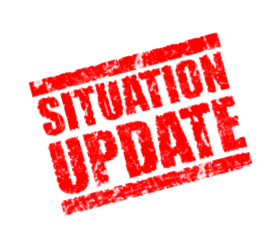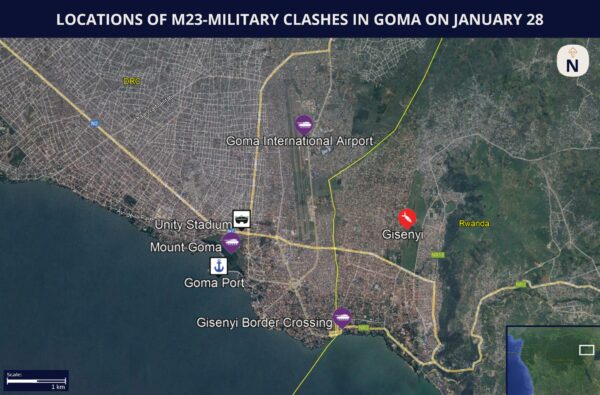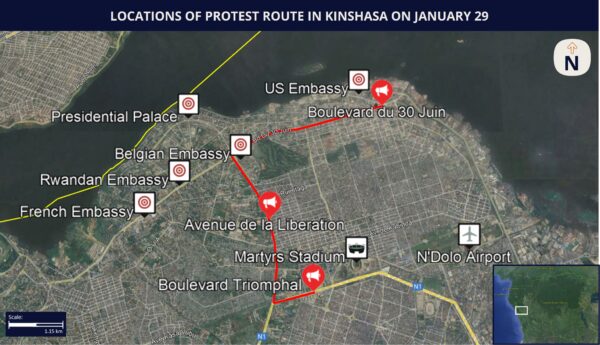28
Jan 2025
15:14 UTC
DRC SITUATION UPDATE: Fighting ongoing as M23 rebels claim control over Goma’s airport, North Kivu Province, amid violent unrest in Kinshasa on January 28
Executive Summary
- The March 23 Movement (M23) rebels claimed to have seized control of Goma International Airport in North Kivu’s provincial capital as fighting continues since January 26. This is not confirmed, and amid government claims to still control some parts of the city, the exact image of who controls the town is unclear. Fighting will continue in the immediate future
- Meanwhile, amid failed international and regional mediation efforts, protesters denouncing perceived international inaction attacked foreign embassies in Kinshasa. This reflects widespread frustration, with the government potentially utilizing this to pressure international actors to act against the rebels and Rwanda. Similar protests and unrest will likely recur over the coming days.
Current Situation
- In an official notice, the March 23 Movement (M23) rebels’ spokesperson claimed the rebels captured Goma International Airport in North Kivu Province on January 28, which pro-Congolese sources dismissed as fake news.
- Clashes persisted in several parts of Goma on January 28, with rebels’ control reported mostly in its western parts. This is despite reports that the UN peacekeepers brokered a ceasefire deal on the evening of January 27.
- Earlier, on January 27, the government spokesperson confirmed the presence of M23 rebels and Rwandan soldiers in Goma but reassured that the military was fully mobilized to prevent “carnage”. Additional prominent Congolese officials stated the military still controlled parts of the city, amid reports that it regained control of the National Radio and Television Station (RTNC) facility on Mount Goma.
- 17 civilians were reportedly killed amid the fighting. Power and water supplies are reportedly still cut, and the city also experiences continuous disruptions in internet connectivity.
- The South African National Defence Forces (SANDF) confirmed that three of its members were killed by mortar shelling near Goma International Airport on January 27. Another soldier died of previous injuries. The SANDF dismissed videos allegedly depicting its forces surrendering to M23.
- Dozens of Congolese soldiers reportedly fled to the Goma-Gisenyi border crossing and surrendered on January 27. Five Rwanda civilians were killed and 35 others were injured when mortar shells fell in Gisenyi, in Rwanda’s Rubavu District.
- Congolese President Felix Tshisekedi and Rwandan President Paul Kagame are scheduled to attend an East African Community (EAC) meeting on January 29. Tshisekedi reportedly stated that the war “had not yet begun”.
- Protests over the M23’s offensive and perceived international inaction in Kinshasa on January 28 devolved into widespread unrest targeting foreign embassies, including those of the US, France, Belgium, Rwanda, and Uganda. Rioters reportedly broke into the Rwandan and Ugandan embassies, engaging in vandalism and looting. The outer wall of the French embassy was torched.
- The ruling Union for Democracy and Social Progress (UDPS) party announced a protest march in Kinshasa on January 29. Participants will gather at Palais du Peuple at 10:00 and march to the Central Station via Boulevard Triomphal, Avenue de la Liberation, and Boulevard du 30 Juin. The protest is held in support of the Congolese military.
Source: AFC/M23 communique
Assessments & Forecast
- The recent developments in Goma reflect a continued unclarity concerning the exact situation on the ground, particularly with regard to the question of whether the rebels have achieved their goal of securing full control of the city, as they claim. This comes after the rebels launched a large-scale offensive against the city on January 26 and claimed to have seized it on the morning of January 27. However, the fact that M23 claimed to have finally established control over Goma’s airport on January 28 indicates that the rebels themselves acknowledge the persistence of Congolese military pockets in the city. This lack of clarity concerning the situation can be a result of journalists facing difficulties in reporting from Goma itself, in addition to the fact that fighting for territorial control remains ongoing despite the rebels’ efforts to portray complete control. Statements by Congolese officials are likely aimed at asserting a sense of control over the situation to reassure the population, in addition to rallying public support with implied or direct threats against Rwanda.
- In this context, while the reported spillover of fighting into Rwandan territory was anticipated given the proximity to Goma, it also represents a potential for further escalation, including possible incidents of direct fighting between the Congolese and Rwandan forces. FORECAST: Given the current circumstances, fighting for territorial control of strategic sites in Goma will likely continue in the immediate future. Given the rebels’ momentum, they are likely to eventually succeed in capturing these strategic locations, including Goma’s airport, among others. The continuous fighting is expected to include the use of mortar shells and other artillery in addition to light weapons being used amid urban fighting. Fighting is unlikely to cease in the near term considering the evident failure of mediation efforts, with the scheduled EAC meeting likely not leading to direct negotiations. While international powers might increase pressure on M23 and Rwanda to cease their aggression, the rebels and Kigali will likely insist that the Congolese government accept holding direct negotiations with M23 leaders, which Kinshasa will likely continue dismissing, at least for now.
- Meanwhile, the scale and violence of the unrest in the capital denote heightened frustrations over the M23’s continued advances, entrenched grievances over foreign powers’ perceived inaction amid the conflict, and locals’ proclivity to engage in unruly behavior and target sensitive facilities, notably foreign embassies. The security forces’ inability to contain these events and prevent vandalism and looting of embassies might be related to insufficient deployments or a low level of professionalism. That said, this could also be a result of a deliberate policy to allow civilians to express their frustrations toward external actors rather than Tshisekedi and his government, and the possibility that government-related elements even knowingly allowed or orchestrated these incidents of unrest cannot be excluded. In such a scenario, the authorities could have perceived that such violence against foreign embassies would force international powers to take a harsher stance against Rwanda.
- FORECAST: In these circumstances, protests and civil unrest will persist in Kinshasa over the coming days, including during the planned January 28 demonstration. The UDPS-led protest march will likely attract a wide turnout given the widespread public grievances over the M23’s advances on Goma, with participants possibly ranging in the low-to-mid thousands. In this context, and although the protest is organized in support of the Congolese authorities, the ongoing heightened tensions suggest that this will likely trigger additional instances of unrest across Kinshasa, including near sensitive locations, such as foreign embassies. This will likely be accompanied by international pressure on the Congolese authorities to quell the unrest and protect their embassies and nationals, with the government likely deploying significant police forces to these venues and across Kinshasa. This increases the potential for harsher security crackdowns on those engaging in acts of unrest. The security landscape in the capital is, therefore, expected to remain volatile over the coming days.
Recommendations
- Those operating or residing in Kinshasa on January 28 are advised to minimize nonessential movement in central Kinshasa, particularly the Gombe Commune, over the coming hours and days due to the ongoing unrest, the upcoming protest actions, and the anticipated security crackdowns.
- Avoid all travel to Goma. Those operating or residing in Goma are advised to shelter in place due to the closure of evacuation routes.
- Avoid all travel to Masisi, Nyiragongo, Rutshuru, Walikale, Lubero, and Beni territories in North Kivu Province, as well as to Kalehe Territory in South Kivu Province given the elevated risks associated with the ongoing fighting.
COUNTRY RISK LEVEL
High
AFFECTED AREA
Goma, North Kivu Province, DRC
INCIDENT RISK LEVEL
Extreme
STRENGTH OF SOURCE
Credible
Executive Summary
- The March 23 Movement (M23) rebels claimed to have seized control of Goma International Airport in North Kivu’s provincial capital as fighting continues since January 26. This is not confirmed, and amid government claims to still control some parts of the city, the exact image of who controls the town is unclear. Fighting will continue in the immediate future
- Meanwhile, amid failed international and regional mediation efforts, protesters denouncing perceived international inaction attacked foreign embassies in Kinshasa. This reflects widespread frustration, with the government potentially utilizing this to pressure international actors to act against the rebels and Rwanda. Similar protests and unrest will likely recur over the coming days.
Current Situation
- In an official notice, the March 23 Movement (M23) rebels’ spokesperson claimed the rebels captured Goma International Airport in North Kivu Province on January 28, which pro-Congolese sources dismissed as fake news.
- Clashes persisted in several parts of Goma on January 28, with rebels’ control reported mostly in its western parts. This is despite reports that the UN peacekeepers brokered a ceasefire deal on the evening of January 27.
- Earlier, on January 27, the government spokesperson confirmed the presence of M23 rebels and Rwandan soldiers in Goma but reassured that the military was fully mobilized to prevent “carnage”. Additional prominent Congolese officials stated the military still controlled parts of the city, amid reports that it regained control of the National Radio and Television Station (RTNC) facility on Mount Goma.
- 17 civilians were reportedly killed amid the fighting. Power and water supplies are reportedly still cut, and the city also experiences continuous disruptions in internet connectivity.
- The South African National Defence Forces (SANDF) confirmed that three of its members were killed by mortar shelling near Goma International Airport on January 27. Another soldier died of previous injuries. The SANDF dismissed videos allegedly depicting its forces surrendering to M23.
- Dozens of Congolese soldiers reportedly fled to the Goma-Gisenyi border crossing and surrendered on January 27. Five Rwanda civilians were killed and 35 others were injured when mortar shells fell in Gisenyi, in Rwanda’s Rubavu District.
- Congolese President Felix Tshisekedi and Rwandan President Paul Kagame are scheduled to attend an East African Community (EAC) meeting on January 29. Tshisekedi reportedly stated that the war “had not yet begun”.
- Protests over the M23’s offensive and perceived international inaction in Kinshasa on January 28 devolved into widespread unrest targeting foreign embassies, including those of the US, France, Belgium, Rwanda, and Uganda. Rioters reportedly broke into the Rwandan and Ugandan embassies, engaging in vandalism and looting. The outer wall of the French embassy was torched.
- The ruling Union for Democracy and Social Progress (UDPS) party announced a protest march in Kinshasa on January 29. Participants will gather at Palais du Peuple at 10:00 and march to the Central Station via Boulevard Triomphal, Avenue de la Liberation, and Boulevard du 30 Juin. The protest is held in support of the Congolese military.
Source: AFC/M23 communique
Assessments & Forecast
- The recent developments in Goma reflect a continued unclarity concerning the exact situation on the ground, particularly with regard to the question of whether the rebels have achieved their goal of securing full control of the city, as they claim. This comes after the rebels launched a large-scale offensive against the city on January 26 and claimed to have seized it on the morning of January 27. However, the fact that M23 claimed to have finally established control over Goma’s airport on January 28 indicates that the rebels themselves acknowledge the persistence of Congolese military pockets in the city. This lack of clarity concerning the situation can be a result of journalists facing difficulties in reporting from Goma itself, in addition to the fact that fighting for territorial control remains ongoing despite the rebels’ efforts to portray complete control. Statements by Congolese officials are likely aimed at asserting a sense of control over the situation to reassure the population, in addition to rallying public support with implied or direct threats against Rwanda.
- In this context, while the reported spillover of fighting into Rwandan territory was anticipated given the proximity to Goma, it also represents a potential for further escalation, including possible incidents of direct fighting between the Congolese and Rwandan forces. FORECAST: Given the current circumstances, fighting for territorial control of strategic sites in Goma will likely continue in the immediate future. Given the rebels’ momentum, they are likely to eventually succeed in capturing these strategic locations, including Goma’s airport, among others. The continuous fighting is expected to include the use of mortar shells and other artillery in addition to light weapons being used amid urban fighting. Fighting is unlikely to cease in the near term considering the evident failure of mediation efforts, with the scheduled EAC meeting likely not leading to direct negotiations. While international powers might increase pressure on M23 and Rwanda to cease their aggression, the rebels and Kigali will likely insist that the Congolese government accept holding direct negotiations with M23 leaders, which Kinshasa will likely continue dismissing, at least for now.
- Meanwhile, the scale and violence of the unrest in the capital denote heightened frustrations over the M23’s continued advances, entrenched grievances over foreign powers’ perceived inaction amid the conflict, and locals’ proclivity to engage in unruly behavior and target sensitive facilities, notably foreign embassies. The security forces’ inability to contain these events and prevent vandalism and looting of embassies might be related to insufficient deployments or a low level of professionalism. That said, this could also be a result of a deliberate policy to allow civilians to express their frustrations toward external actors rather than Tshisekedi and his government, and the possibility that government-related elements even knowingly allowed or orchestrated these incidents of unrest cannot be excluded. In such a scenario, the authorities could have perceived that such violence against foreign embassies would force international powers to take a harsher stance against Rwanda.
- FORECAST: In these circumstances, protests and civil unrest will persist in Kinshasa over the coming days, including during the planned January 28 demonstration. The UDPS-led protest march will likely attract a wide turnout given the widespread public grievances over the M23’s advances on Goma, with participants possibly ranging in the low-to-mid thousands. In this context, and although the protest is organized in support of the Congolese authorities, the ongoing heightened tensions suggest that this will likely trigger additional instances of unrest across Kinshasa, including near sensitive locations, such as foreign embassies. This will likely be accompanied by international pressure on the Congolese authorities to quell the unrest and protect their embassies and nationals, with the government likely deploying significant police forces to these venues and across Kinshasa. This increases the potential for harsher security crackdowns on those engaging in acts of unrest. The security landscape in the capital is, therefore, expected to remain volatile over the coming days.
Recommendations
- Those operating or residing in Kinshasa on January 28 are advised to minimize nonessential movement in central Kinshasa, particularly the Gombe Commune, over the coming hours and days due to the ongoing unrest, the upcoming protest actions, and the anticipated security crackdowns.
- Avoid all travel to Goma. Those operating or residing in Goma are advised to shelter in place due to the closure of evacuation routes.
- Avoid all travel to Masisi, Nyiragongo, Rutshuru, Walikale, Lubero, and Beni territories in North Kivu Province, as well as to Kalehe Territory in South Kivu Province given the elevated risks associated with the ongoing fighting.



